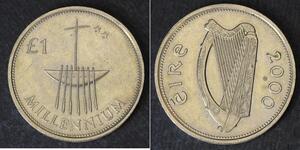1 Tetradrachm Ancient Greece (1100BC-330) Silver Seleucus I Nicat ...
Metal:
State:
Issue year(s):
312BC - 281BC
Person:
Seleukid Kingdom. Seleukos I, Nikator, 312-281 BC. AR Tetradrachm (16.80 g). Helmeted bust of hero right, assimilating Dionysus, Alexander, and Seleukos, wearing helmet covered with panther skin and adorned with bull’s horn and ear, panther skin tied around neck. Reverse: Nike standing right, crowning trophy of arms. SC 174.3.
type to read more
Head of Seleucus I right, wearing helmet covered with panther skin and adorned with bull’s ears and horns, panther skin tied around neck, dotted border. / ΒΑΣΙΛΕΩΣ ΣEΛΕYKOY, Nike standing right, crowning trophy, monogram between. Reference: Hougton & Lober 173.4; Hoover 20; Newell, ESM 426.
*Numismatic Note: Debate has long swirled regarding the identity of the ‘helmeted hero’ appearing on the obverse of this type – is it Seleucus I himself, or Alexander the Great, or a composite demigod incorporating features of Seleucus, Alexander and Dionysus? In the new Handbook of Syrian Coins (CNG, 2009), Oliver Hoover opts for identifying the portrait as an idealized image of Seleucus himself. Destined to be the longest-surviving of the ‘Successors’ of Alexander, Seleukos had a difficult time establishing his power. Alloted the satrapy of Babylon in 321 B.C. he was ousted from this position five years later, by Antigonos the One-eyed, and fled to his friend Ptolemy in Egypt. In 312 B.C. he regained Babylon and it is from this even that the Seleukid Era is dated. Seleukos gradually consolidated his power and in 305 B.C. took the title of King. From 305-3 he campaigned in the east, extending his rule as far as India. With his defeat of Lysimachos in 281 he became master of the whole of Alexander’s empire, except Egypt; but the following year he was assassinated by Ptolemy Keraunos, a renegade son of his late friend, the King of Egypt. The territorial extent of this might realm varied greatly from period to period. At its zenith, under Seleukos I and Antiochos I, it compromised almost the whole of Alexander’s conquests, except Egypt. In the mid-3rd century the easternmost provinces were lost when both Baktria and Parthia achieved independence. Antiochos III, the Great, attempted to regain the lost territories, but he was only partially successful and in 190 B.C. he was defeated by the Romans at the battle of Magnesia. This destroyed the Seleukid power in Asia Minor, their former possessions passed to Rome’s ally, the Kingdom of Pergamon. The Seleukid Kingdom, now restricted to Syria and the surrounding area, maintained a precarious existence until 64 B.C. when it finally succumbed to Pompey the Great.
7
coins in the group
| 1 | 2 |
|---|
(405 X 191 pixels, file size: ~23K)
Posted by: anonymous 2015-08-19
[ 2784] Kingdom of Syria Seleucid Kings, Seleukos I Nikator, 312-280 B.C. Silver Tetradrachm (17.12 gm). Susa, c. 305-294 BC. Head of Seleucus I right, wearing helmet covered with panther skin and adorned with bull's ears and horns, panther skin tied around neck, dotted border. / ΒΑΣΙΛΕΩΣ ΣEΛ ...
(777 X 379 pixels, file size: ~372K)
Posted by: anonymous 2015-08-21
ANCIENT COINS. GREEK COINS. Kingdom of Syria, Seleukid Kings, Seleukos I Nikator (312-280 B.C.), Silver Drachm, 4.12g, 2h.Mint of Susa, struck 305-295 B.C.Bust of Alexander the Great as Dionysos facing right, wearing an Attic helmet covered with a panther-skin and adorned with a bull’s ear and ...
(1000 X 488 pixels, file size: ~129K)
Posted by: anonymous 2015-08-19
The Prospero Collection of Ancient Greek Coins. KINGDOM OF SYRIA. Seleucid Kings, Seleukos I Nikator (312-281 B.C.), Silver Tetradrachm, 16.54g,. Mint of Susa, struck c.305/4-295 B.C. Male head (Seleukos / Alexander?) facing to right, wearing a helmet covered with a panther-skin, adorned with t ...
(1000 X 496 pixels, file size: ~136K)
Posted by: anonymous 2015-08-19
The Prospero Collection of Ancient Greek Coins. KINGDOM OF SYRIA. Seleucid Kings, Seleukos I Nikator (312-281 B.C.), Silver Tetradrachm, 16.69g,. Mint of Susa, struck c.305/4-295 B.C. Male head (Seleukos / Alexander?) facing to right, wearing a helmet covered with a panther-skin, adorned with t ...
(1000 X 489 pixels, file size: ~146K)
Posted by: anonymous 2015-08-19
ANCIENT COINS. GREEK COINS. SELEUKID KINGDOM OF SYRIA. SELEUKOS I NIKATOR, 312-281 B.C. Tetradrachm, Susa, after 305/4 B.C. 16.97 g. Heroic head r. wearing helmet decorated with panther skin, bull’s ear and horns. Rev. BA ; 2 4. A ; (off flan right) ;. 4. = 3 8 = left, winged Nike standing righ ...
(1205 X 603 pixels, file size: ~168K)
Posted by: anonymous 2015-03-06
Seleukid Kingdom. Seleukos I, Nikator, 312-281 BC. AR Tetradrachm (16.80 g). Helmeted bust of hero right, assimilating Dionysus, Alexander, and Seleukos, wearing helmet covered with panther skin and adorned with bull's horn and ear, panther skin tied around neck. Reverse: Nike standing right, ...
Related online coin collections
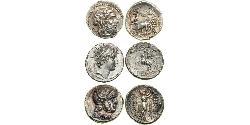
spa1 » Seleukid Empire (312 BC–63 BC) (16 coins)
Seleucid dynasty founded by Seleucus I Nicator following the division of the empire (Macedonia) created by Alexander the Great. Seleucus established himself in Babylon in 312 BC, the year used as the foundation date of the Seleucid Empire. T ...
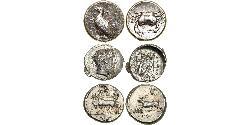
spa1 » Nice Ancient Tetradrachms (33 coins)
Ancient Tetradrachms (Greece, Egypt, Syria, Sicily, Seleukid Kingdom, ...). Most of them couple hundreds years BC. Some of them are 2500+ years old. They have so good mining quality, sharp details and complicated compositions. Definitely anci ...
You may be interested in following coins
2025-05-24
- Historical Coin Prices
2025-05-24
- New coin is added to 1 Pound Ireland (1922 - ) Silver
1 Pound Ireland (1922 - ) Silver
group has 6 coins / 6 prices
⇑
IRELAND REPUBLIC 1 Punt (Pound) 2000 - Copper/Nickel - Millennium - aUNC - 4199
You may be interested in ...

-500-250-5s4Kbzbi_YQAAAFLBcKgLg5u.jpg)
-300-150-di4Kbzbiad8AAAFP0dir70Nf.jpg)
-300-150-g78Kbzbik1MAAAFPXVI1Mk6a.jpg)
-300-150-_cMKbzbi1IUAAAFPsG2r70fs.jpg)
-300-150-YDEKbzbigfoAAAFPJBKr70fs.jpg)
-300-150-R7sKbzbiTbEAAAFPPaGr70g_.jpg)
-300-150-5s4Kbzbi_YQAAAFLBcKgLg5u.jpg)




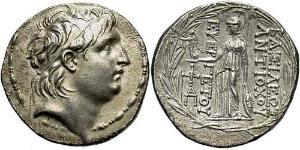

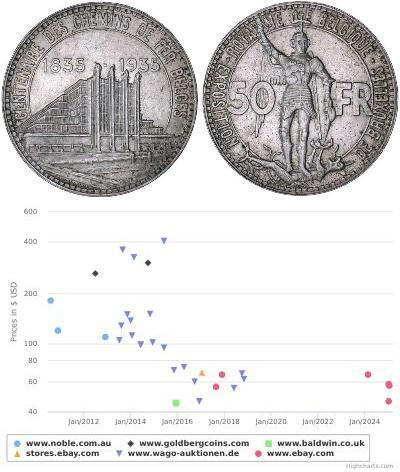
-300-150-IdLBwcI0cU8AAAEqizBDRaSY.jpg)
